Below you may find a list of both the earliest and the most important manuscripts containing the Testimonium Flavianum, each with accompanying links to images.
Curating these images, obtaining licensing rights, and identifying new manuscripts comes at a great cost. For many manuscripts the rights were only able to be procured for the book and not this webpage, yet there are also images presented here that were not able to be presented in the book. To support further work (and perhaps to discover new evidence regarding the authenticity of the Testimonium Flavianum), please consider donating to the Institute for Christian Reflection.
Report any errors here
| Notes | Manuscript Shelfmark with folio and line numbers | Date | Work containing the Testimonium Flavianum | Manuscript Image |
| Earliest Greek manuscript of Antiquities book 18 | Biblioteca Ambrosiana F128 folio 274r line 27—274v line 8 | 11th century | Josephus, Antiquities 18.63–64 | 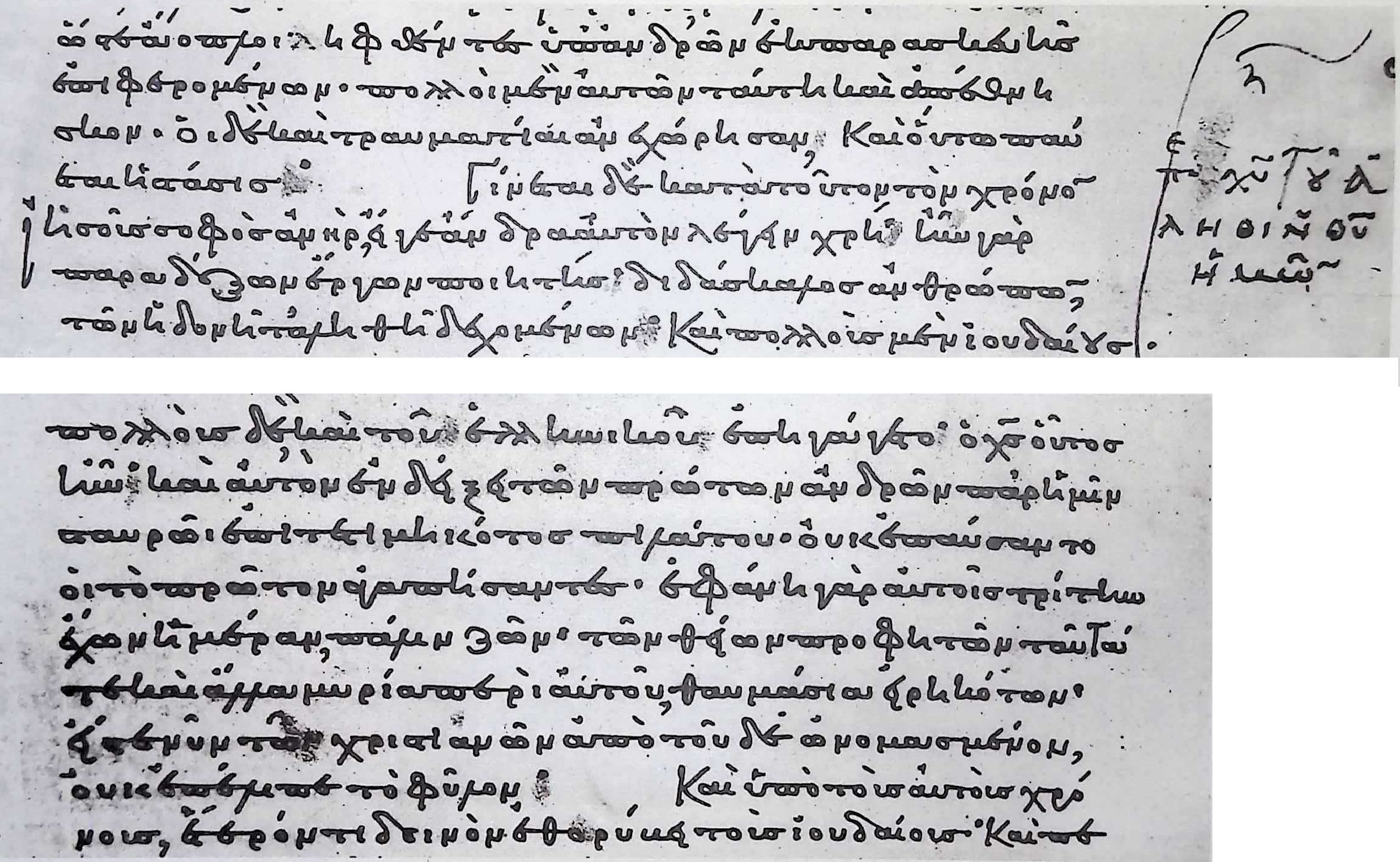 Image source. Link to digitized manuscript (images 533-534) |
| Second earliest Greek manuscript of Antiquities book 18 | Vatican gr.984 folio 152v lines 27–31 | 1354 CE | Josephus, Antiquities 18.63–64 | See image 2 in book or link to digitized manuscript |
| Third earliest Greek manuscript of Antiquities book 18 | Biblioteca Medicea Laurenziana Plut 69.10 folio 360v left column lines 9–24 | 14th/15th century | Josephus, Antiquities 18.63–64 | See image 3 in book or link to digitized manuscript (image 730) |
| Earliest Greek manuscript to contain an excerpt of the Testimonium Flavianum | Vatican gr.148 folio 214v lines 3-13 | 10th/11th century | Excerpt of Testimonium Flavianum | See image 4 in book or link to digitized manuscript (image 226) |
| Second earliest Greek manuscript to contain an excerpt of the Testimonium Flavianum | Vatican gr.342 folio 282v lines 11–24 | 1087/1088 | Excerpt of Testimonium Flavianum | See image 5 in book or link to digitized manuscript |
| Only manuscript of Josephus’ War to contain an interpolation of the TF. Immediately afterwards follows another interpolation from On of the Universe 76-94, a text which had been falsely attributed to Josephus in the medieval world. At some point the passage from On the Universe was crossed out by a later corrector who added a marginal note. | Vossianus gr. F 72 lines 3 – 8 (folio 44r if I correctly read Eisler) | 15th century (first half) | Testimonium Flavianum interpolated after the first word of War 2.168. A later corrector crossed out an additional interpolation of On the Universe and wrote “one must know that this has been correctly crossed out by us since we did not find it in other manuscripts, nor has any of these things been mentioned as being taught in the church of Christ, nor should men relate hereafter…” | 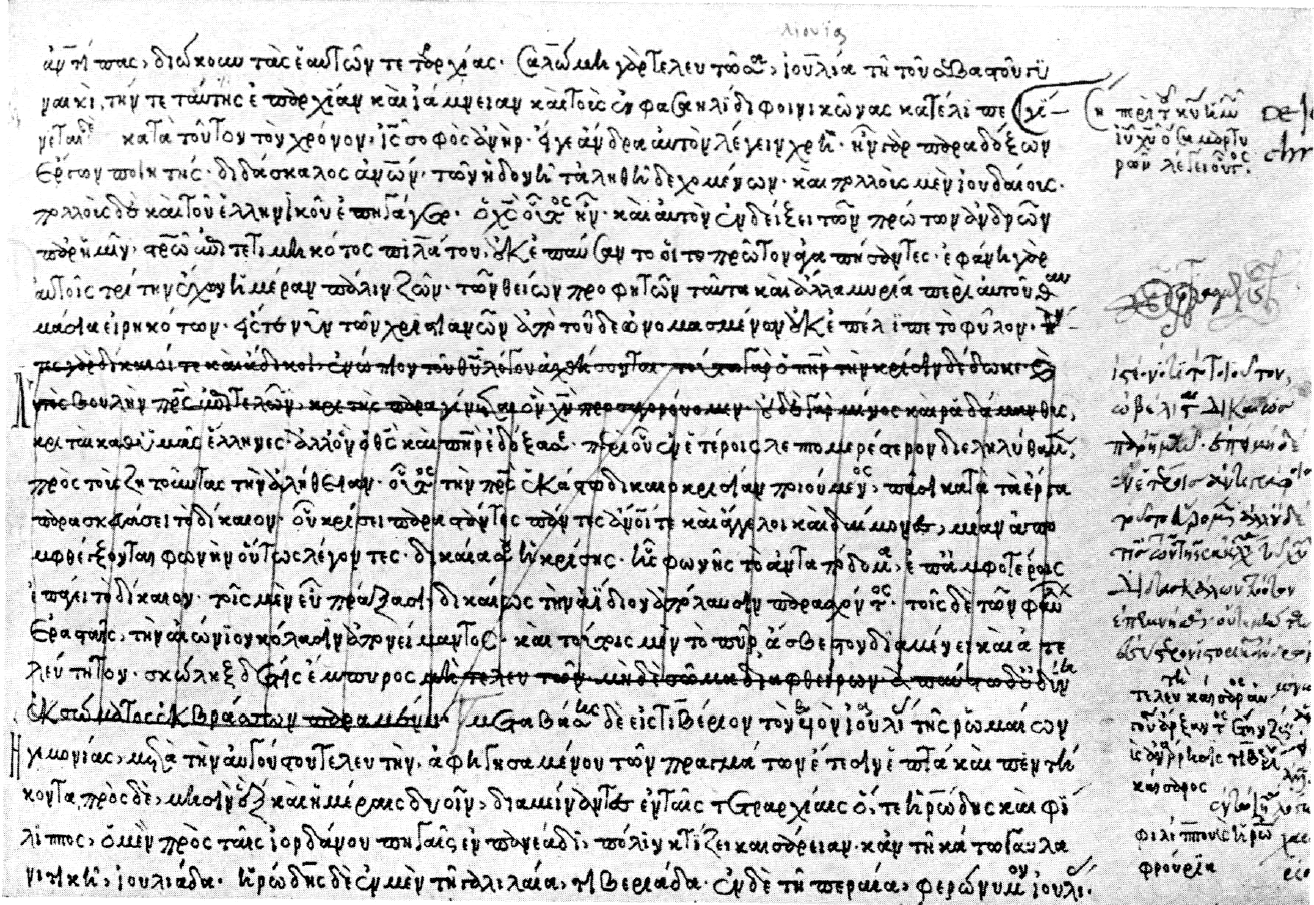 Image source |
| Earliest Greek manuscript of Eusebius, Ecclesiastical History. Contains the important variant “a certain Jesus” (Ἰησοῦς τις). | Bibliothèque nationale de France Grec 1430 folio 26v lines 2–15 | 10th century | Eusebius, Ecclesiastical History 1.11.7–8, composed circa 313 CE | 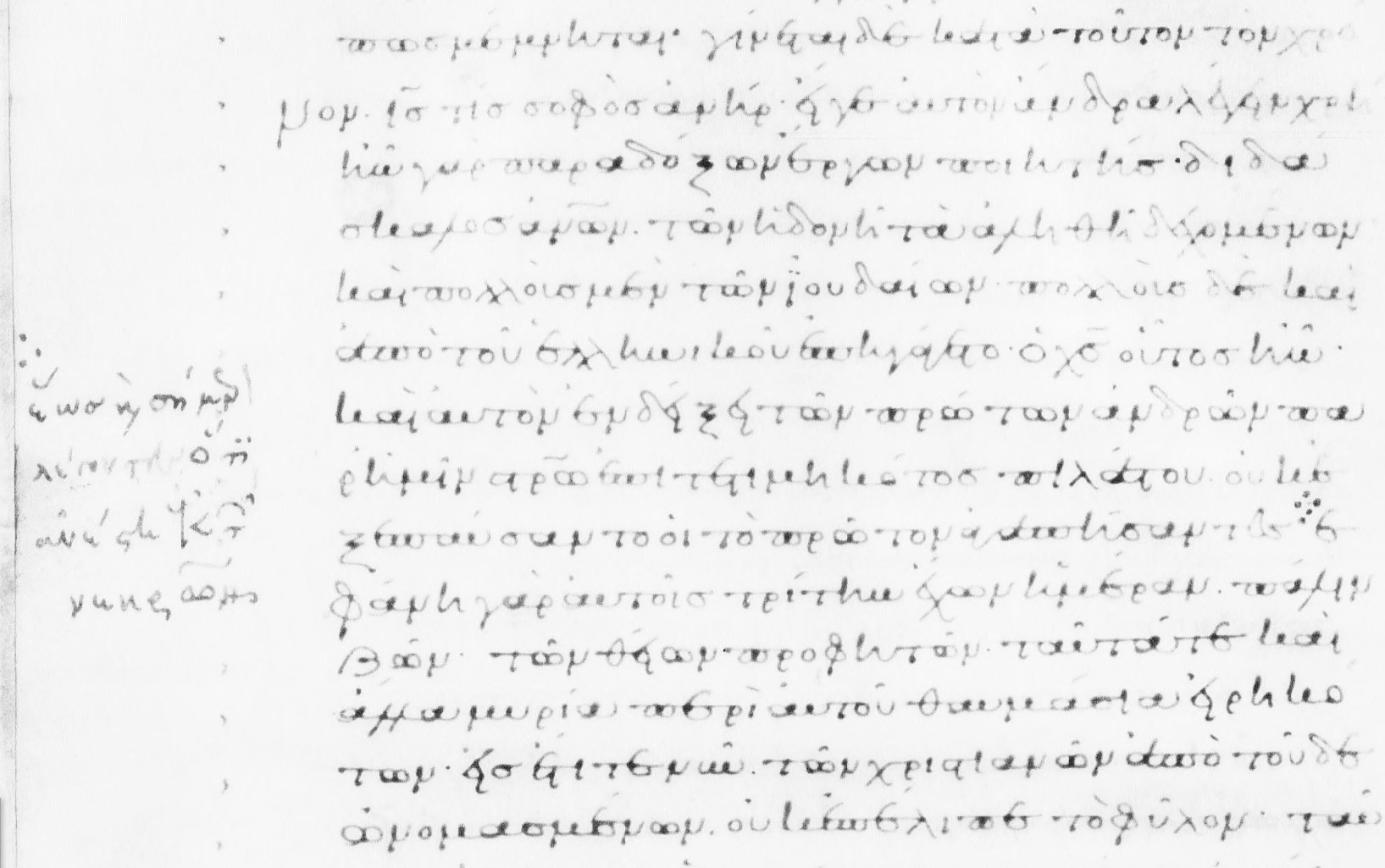 (Source gallica.bnf.fr / BnF) Link to digitized manuscript (image 32) |
| Earliest manuscript of Eusebius’ Demonstration. Evidently the scribe didn’t like Josephus’s phrase “receive with pleasure) (τῶν ἡδονῇ . . . δεχομένων) so he switched it to the more pious ‘revere’ (σεβομένων) | Bibliothèque nationale de France Grec 469 folio 79v lines 29-31— 80r lines 1 – 8 | 12th century | Eusebius, Demonstration 3.5.105 (124b–c) (composed c.318–323 CE) | 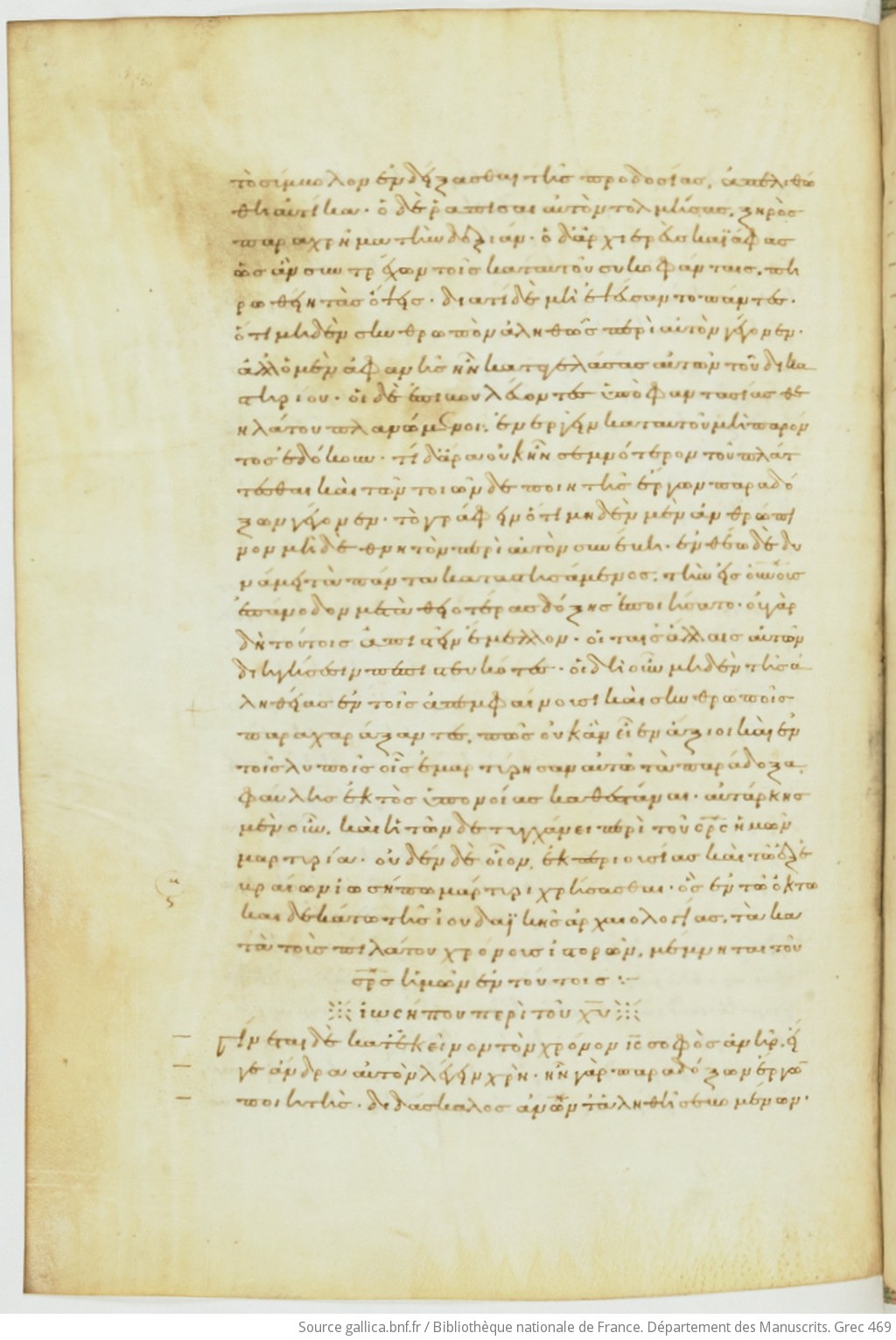 f.79v 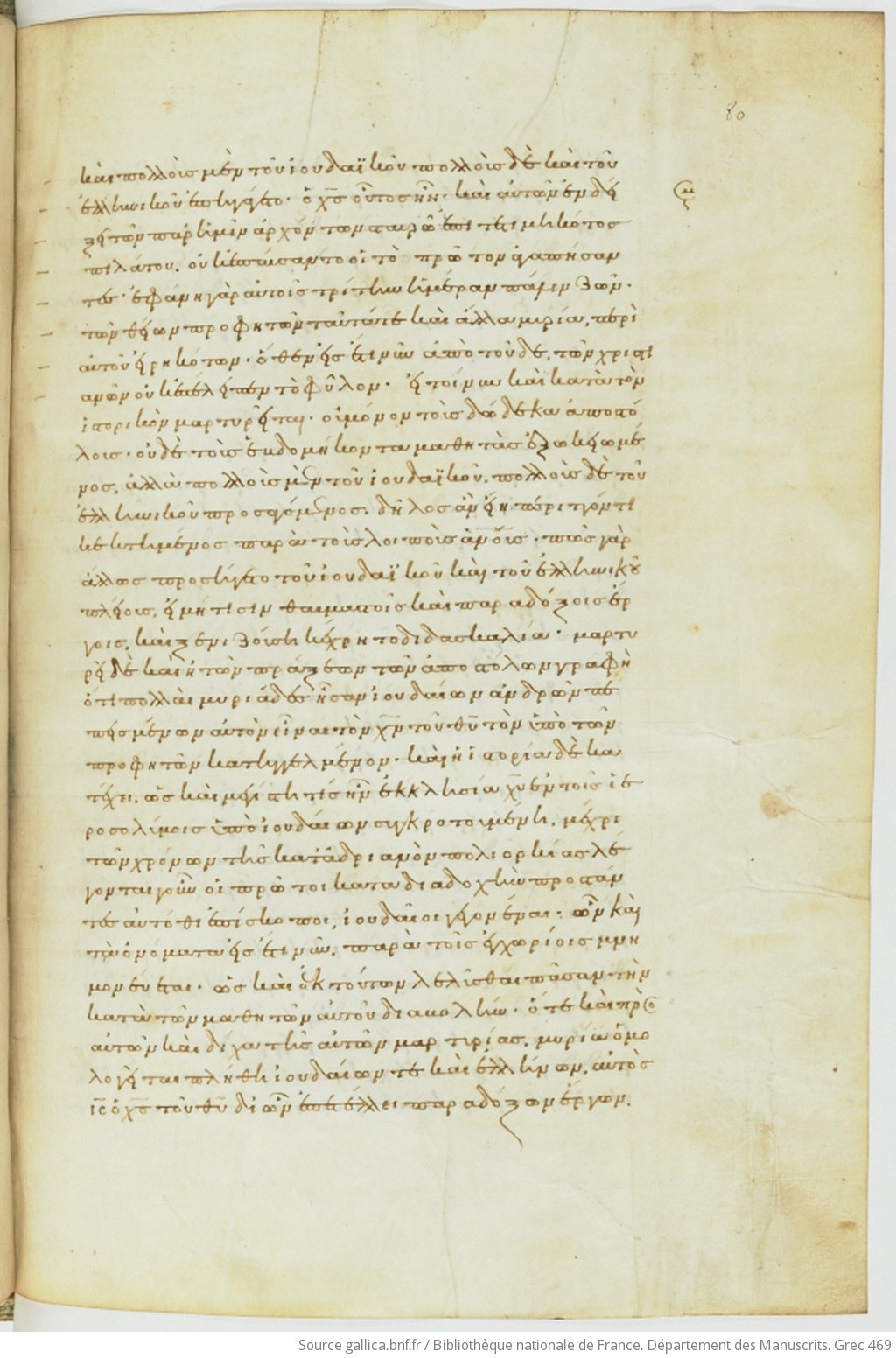 f.80r (Source gallica.bnf.fr / BnF) Link to digitized manuscript (images 170-171) |
| Earliest manuscript of pseudo-Hegesippus, On the Ruin of the City of Jerusalem. Contains an extravagantly pro-Christian paraphrase of the TF, but oddly instead of claiming that Josephus called Jesus the Christ instead it says “they believed in him” (crediderunt in eum). This sounds similar to Jerome’s rendering given below, though chronologically speaking pseudo-Hegesippus could not have used Jerome. | Biblioteca Ambrosiana C 105 inf. folios 85r lines 13-24, 85v lines 1-11 | 6th century | pseudo-Hegesippus, On the Ruin of the City of Jerusalem 2.12.1 (Latin) composed around 370 CE | 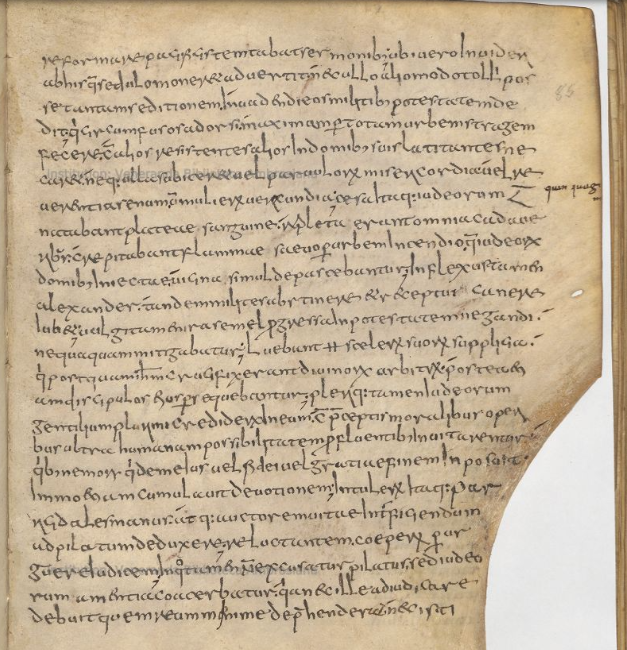 f.85r 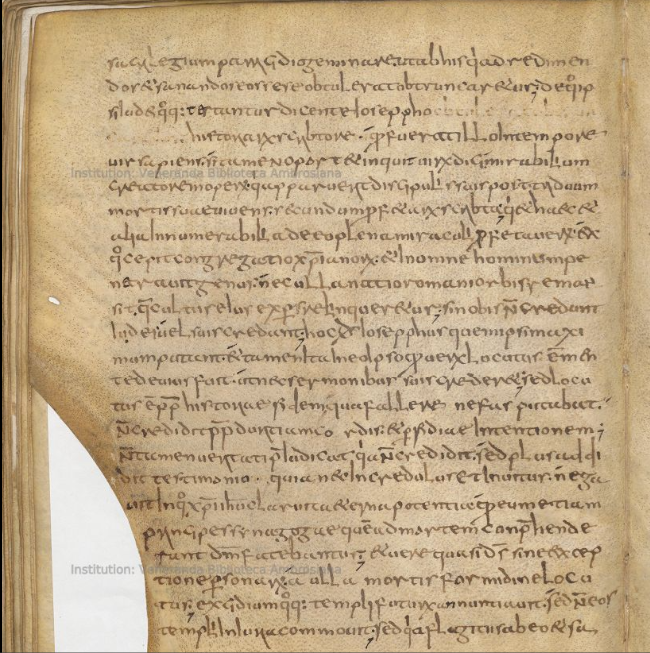 f.85v Link to digitized manuscript Images courtesy of Veneranda Biblioteca Ambrosiana |
| Second earliest manuscript of pseudo-Hegesippus, On the Ruin of the City of Jerusalem (tied with the below manuscript). Contains the same reading as the earliest manuscript, Biblioteca Ambrosiana C 105 inf. | Kassel theol. 65 folios 59r lines 18-36—59v lines 1-5 | 6th/7th century | pseudo-Hegesippus, On the Ruin of the City of Jerusalem 2.12.1 (Latin) composed around 370 CE | 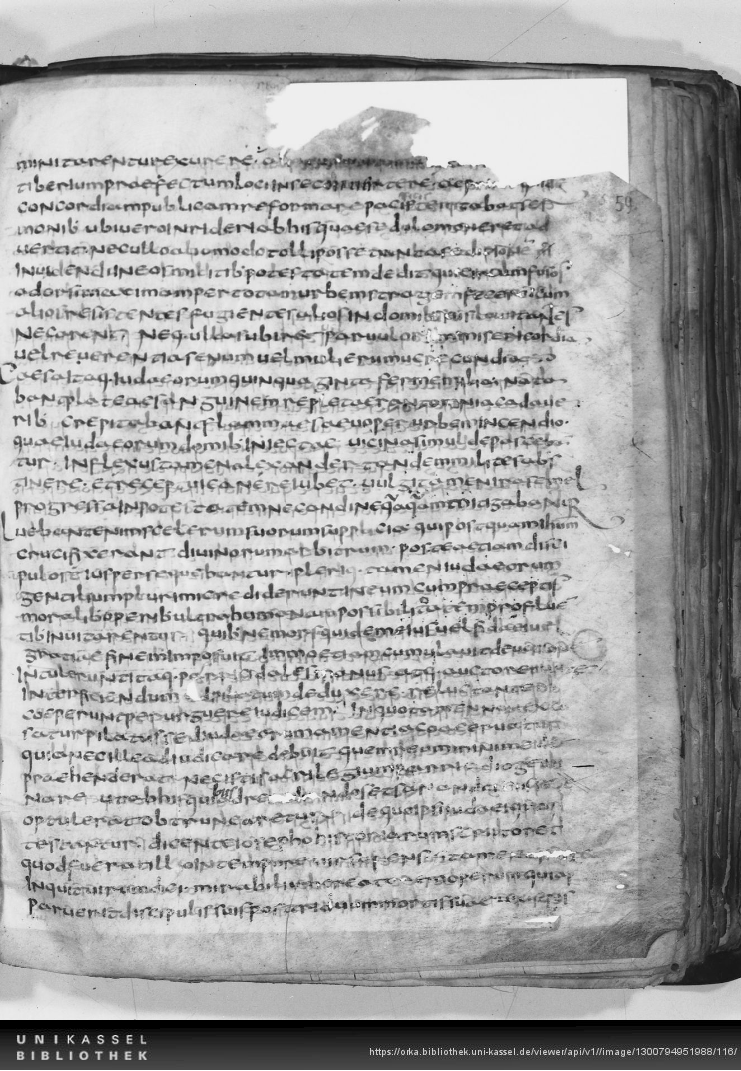 f. 59r  f. 59v |
| Second earliest manuscript of pseudo-Hegesippus, On the Ruin of the City of Jerusalem (tied with the above manuscript). | Bibliothèque nationale de France Lat. 13367 | 6th/7th century | pseudo-Hegesippus, On the Ruin of the City of Jerusalem 2.12.1 (Latin) composed around 370 CE | No links available |
| Earliest manuscript of Jerome’s Illustrious Men. Contains the important variant “was believed to be the Christ” (credebatur esse Christus). | Vatican Reg.lat.2077 folio 15r left column line 7–right column line 11 | 6th/7th century | Jerome, Illustrious Men 13.5–6 (Latin) composed 393 CE | See image 7 in book or link to digitized manuscript |
| Second earliest manuscript of Jerome’s Illustrious Men. Contains the important variant “was believed to be the Christ” (credebatur esse Christus). | Bibliothèque nationale de France Lat. 12161 page 43 lines 2–16 (manuscript numbered according to pages not folios) | 7th century | Jerome, Illustrious Men 13.5–6 (Latin) composed 393 CE | 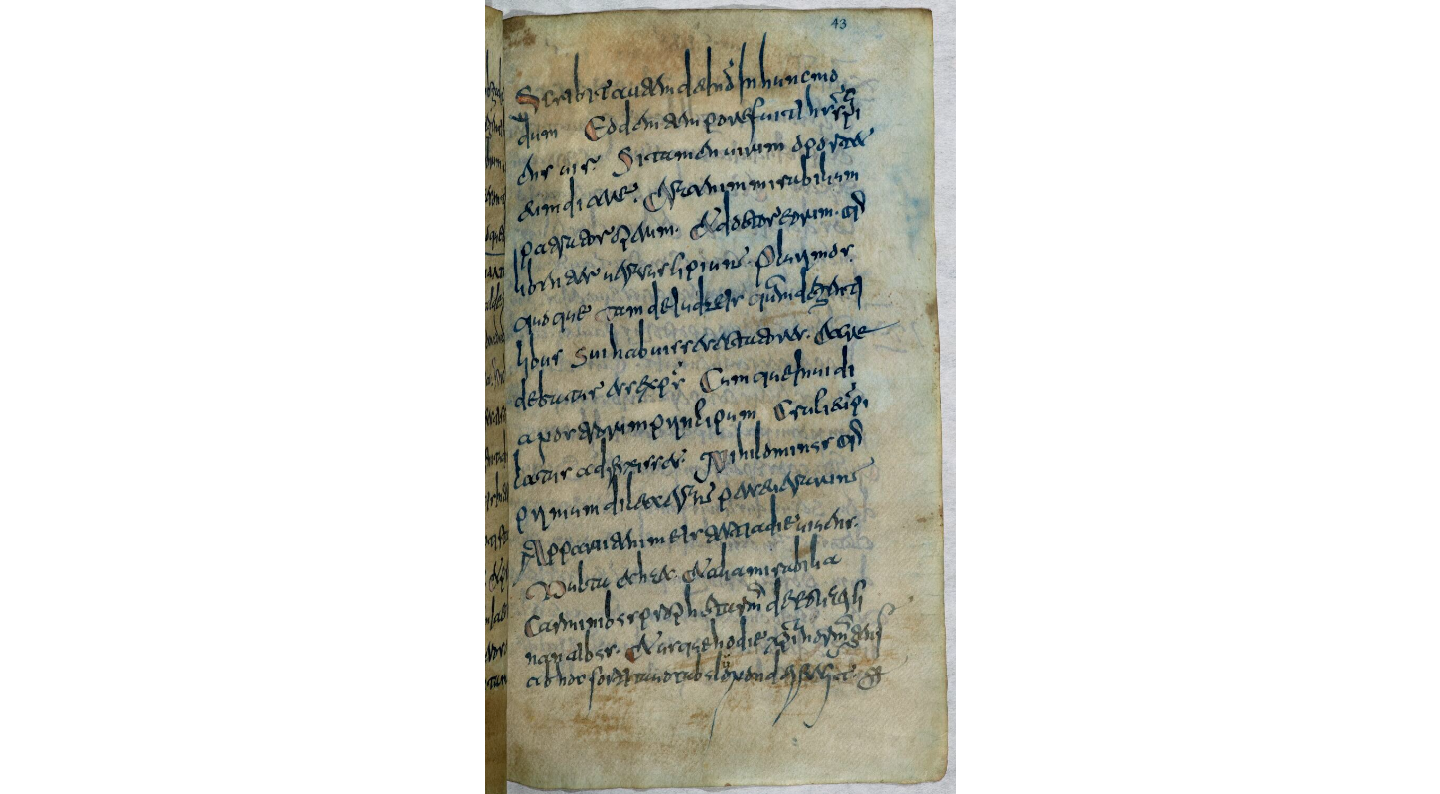 (Source gallica.bnf.fr / BnF) Link to digitized manuscript |
| The earliest manuscript of Rufinus’s Latin translation of Eusebius’s Ecclesiastical History (see BNF Lat. 18282 below for another contender as the earliest). A corrector has crossed out “he was” (erat) and inserted “he was believed to be” (credebatur esse) the Christ, likely to make this version accord with Jerome’s translation. | Bayerische Staatsbibliothek Clm 6383 folio 15r lines 30-38, 15v lines 1-3 | End of 8th century | Rufinus’ Latin Translation of Eusebius, Ecclesiastical History 1.11.7-8, translated 402/403 CE |  f. 15r 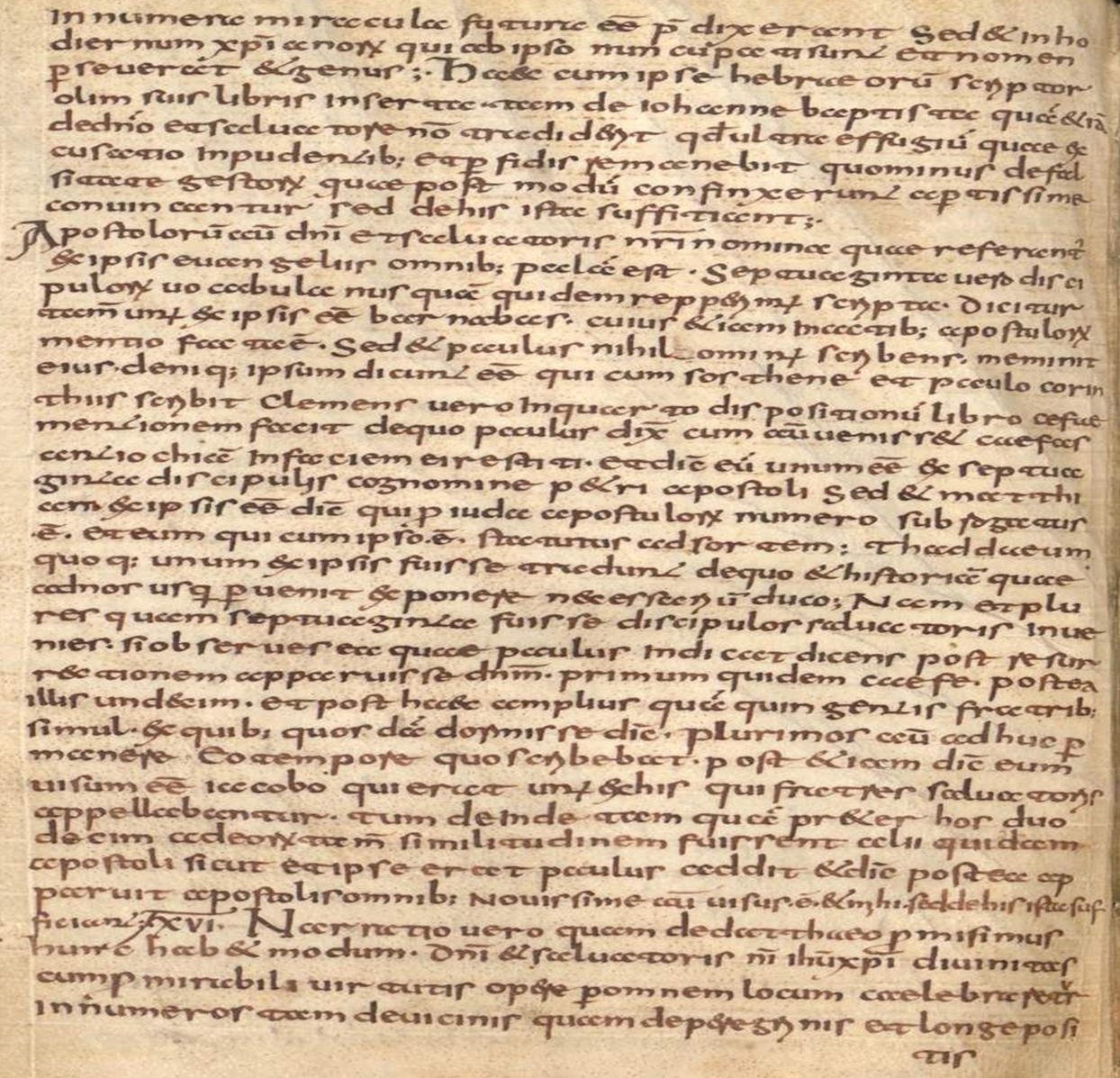 f. 15v Link to digitized manuscript |
| The second earliest manuscript of Rufinus’s Latin translation of Eusebius’s Ecclesiastical History ( though this might be the earliest, see CLM 6383 above). | Bibliothèque nationale de France Lat. 18282 folio 27r lines 19-24, 27v lines 1-8 | 785-800 CE | Rufinus’ Latin Translation of Eusebius, Ecclesiastical History 1.11.7-8, translated 402/403 CE |  f. 27r 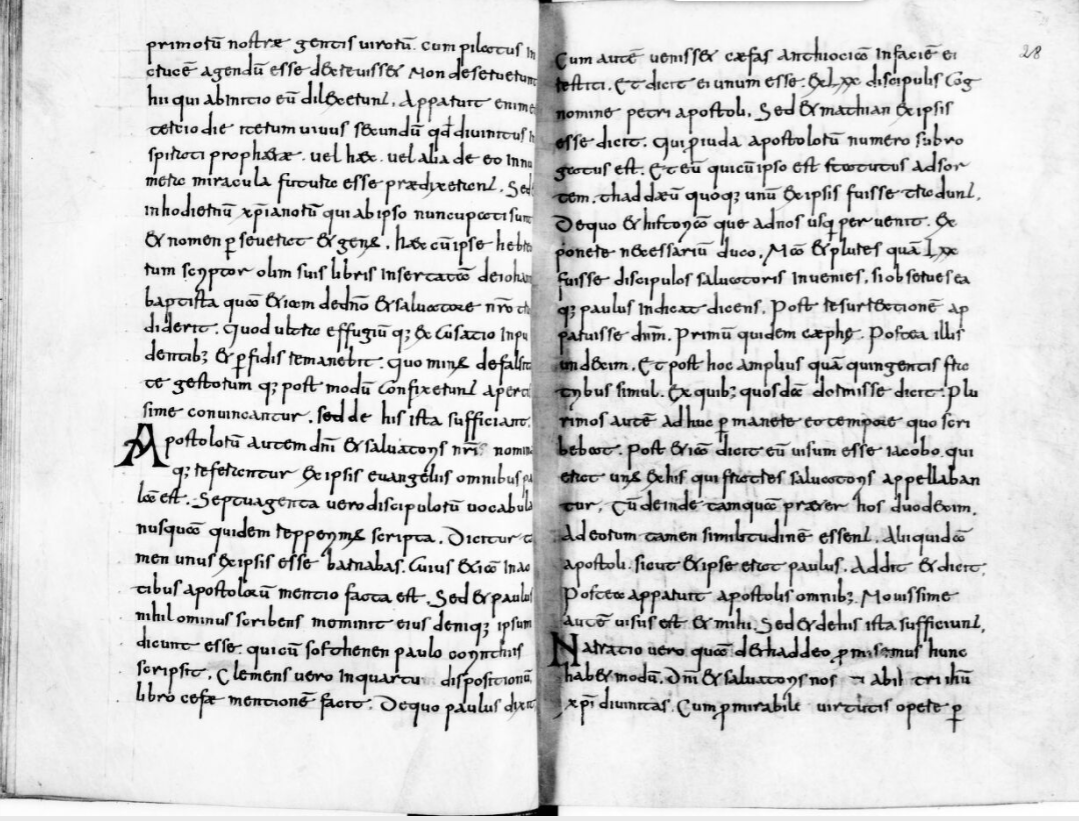 f. 28r Link to digitized manuscript (Source gallica.bnf.fr / BnF) |
| The third earliest manuscript of Rufinus’s Latin translation of Eusebius’s Ecclesiastical History. The main text in the original hand has “was believed to be the Christ” (credebatur esse Christus). But this variant was probably copied from the marginal note of CLM 6381. However, this does suggest that the marginal note given in CLM 6381 must have occurred very soon after the original transcription. | Bayerische Staatsbibliothek Clm 6381 folio 27r lines 4-18 | 820-840 CE | Rufinus’ Latin Translation of Eusebius, Ecclesiastical History 1.11.7-8, translated 402/403 CE | 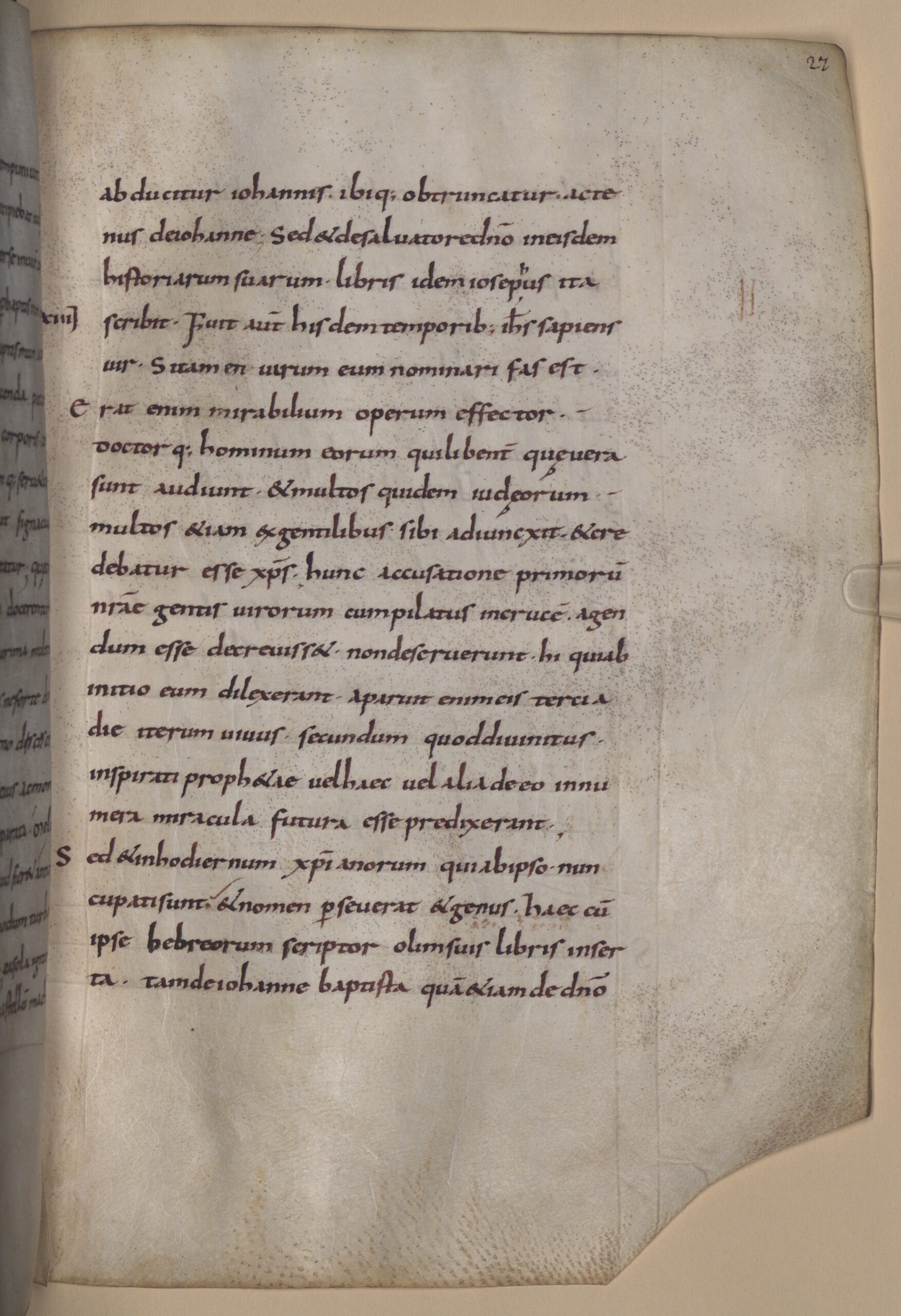 Link to digitized manuscript |
| Earliest manuscript of Cassiodorus’s Latin translation of Antiquities book 18. Cassiodorus (or his team) utilized Rufinus’s translation of the TF verbatim. | Copenhagen Det Kongelige Bibliotek GKS 157 folio 149r lines 28–34 | 7/8th century | Cassiodorus’s Latin translation of the Antiquities, translated in the sixth century | 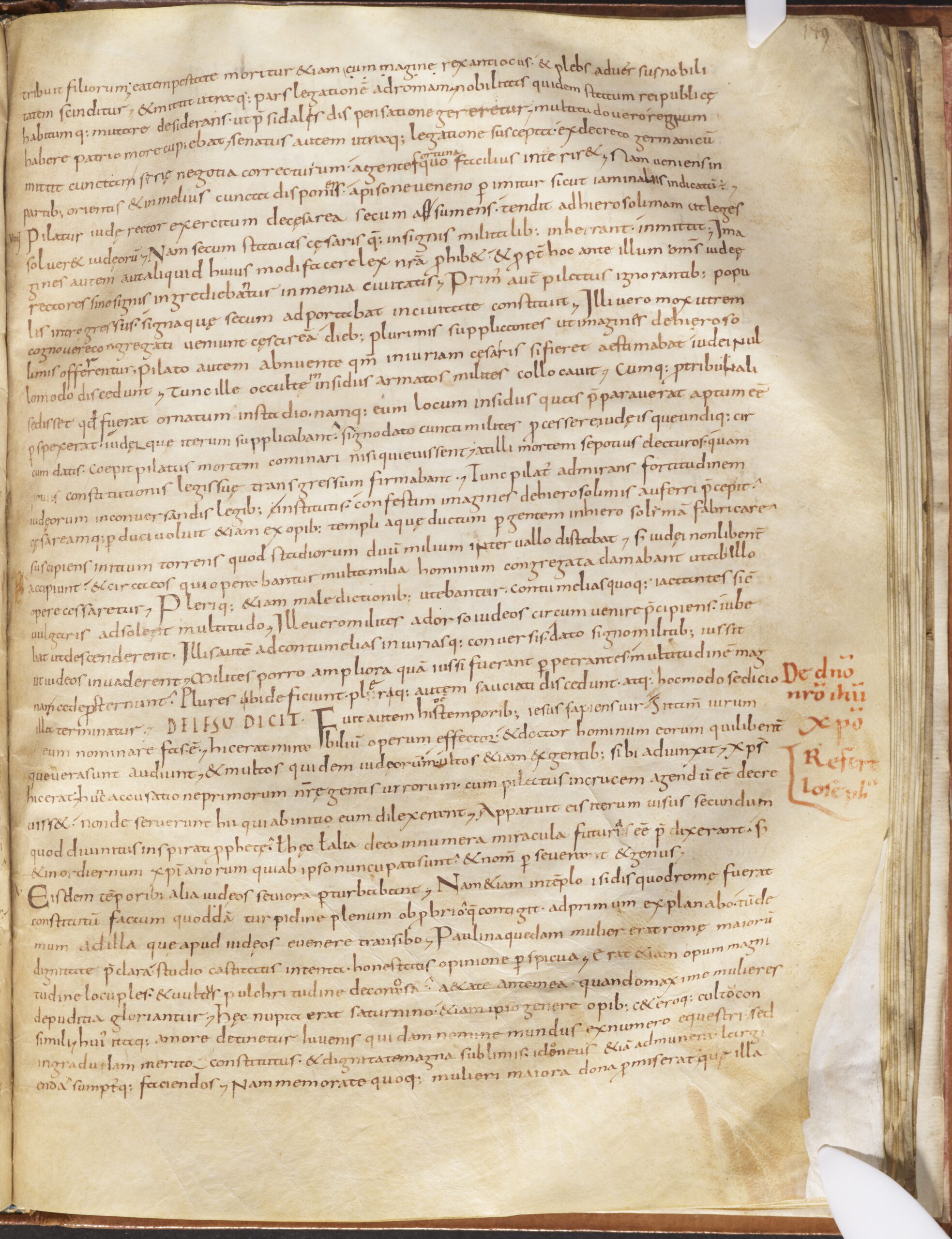 Link to digitized manuscript (image 303) |
| Second earliest manuscript of Cassiodorus’s Latin translation of Antiquities book 18. Cassiodorus (or his team) utilized Rufinus’s translation of the TF verbatim. | Biblioteca Ambrosiana A220 folio 22r lines 3—9 | 800-850 CE | Cassiodorus’s Latin translation of the Antiquities, translated in the sixth century | 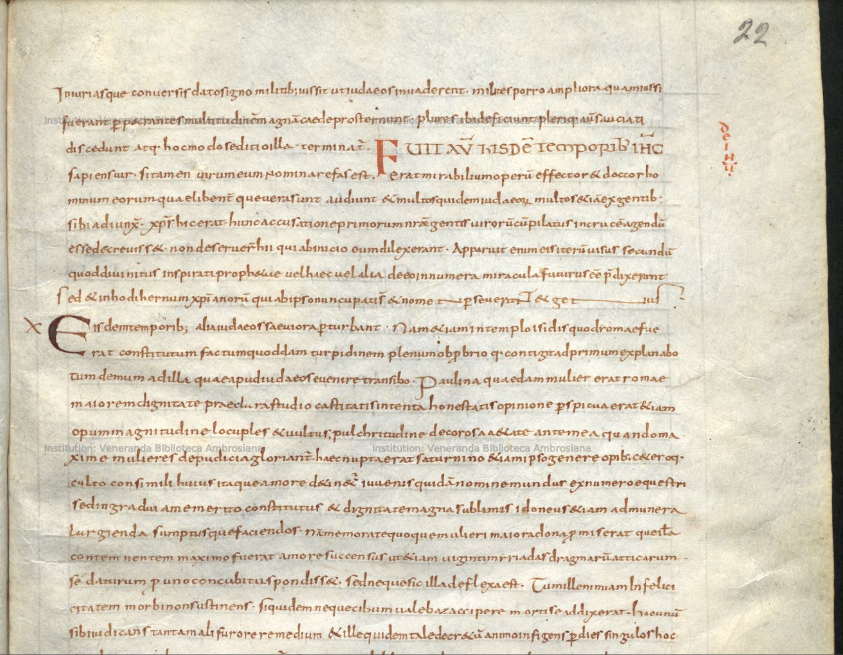 Link to digitized manuscript (image 51) Image courtesy of Veneranda Biblioteca Ambrosiana |
| Third earliest manuscript of Cassiodorus’s Latin translation of Antiquities book 18. Cassiodorus (or his team) utilized Rufinus’s translation of the TF verbatim. | Staatsbibliothek Bamberg Msc.Class.78 folio 221v column 2 lines 3–18 | 850 CE | Cassiodorus’s Latin translation of the Antiquities, translated in the sixth century | 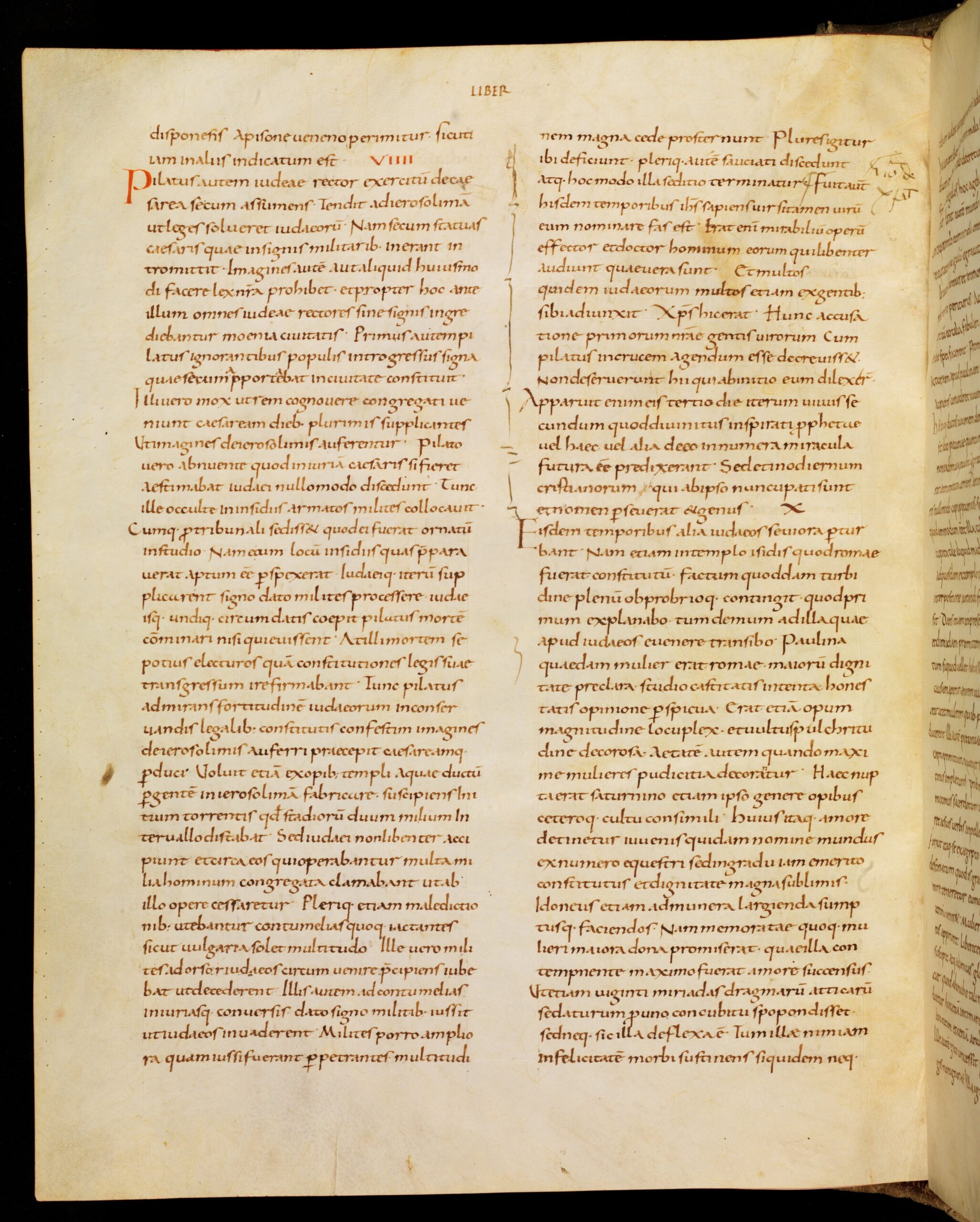 Link to digitized manuscript (image 446) |
| Earliest precisely datable manuscript of any ancient work of literature (please contact me if this is incorrect) | British Library Add.12150 folio 232v column 2 lines 1–29 | 411 CE | Eusebius, Theophany 5.44, composed 325/326 CE (Syriac translation from the fourth century, probably during Eusebius’s lifetime) | 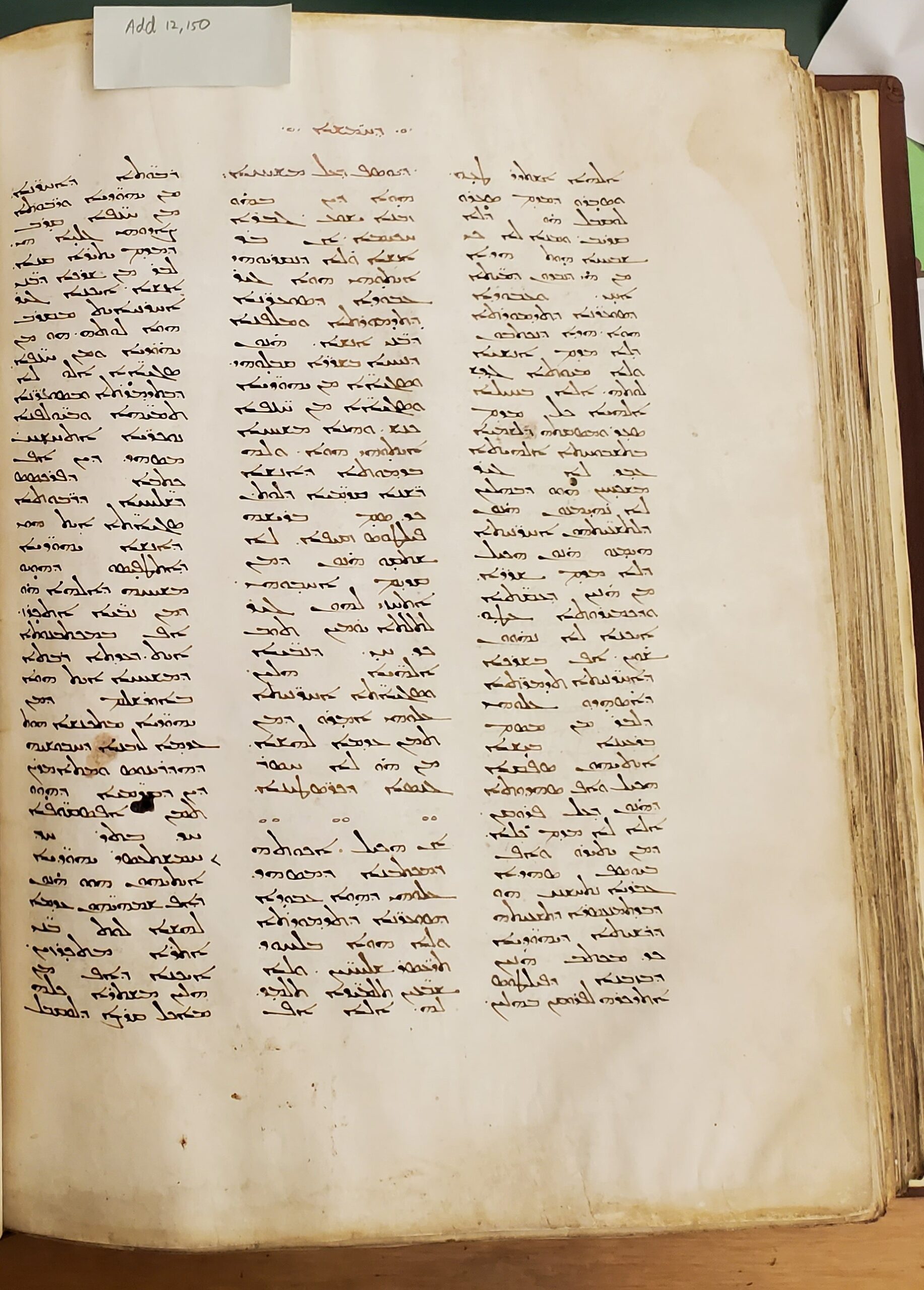 Picture by TC Schmidt August 5, 2024 |
| Second earliest precisely datable manuscript of any ancient work of literature (please contact me if this is incorrect) | National Library of Russia Siriyskaya novaya seria 1, folio 16r column 1 line 25–column 2 line 20 | 462 CE | Eusebius, Ecclesiastical History 1.11.7–8, composed 313 CE (Syriac translation from the fourth century, probably during Eusebius’s lifetime) | See image 9 in book |
| British Library Add.14639 folio 14b col 2 lines 24-31 & 15a lines 1-30 | 6th century | Eusebius, Ecclesiastical History 1.11.7–8 composed 313 CE (Syriac translation from the fourth century, probably during Eusebius’s lifetime) | 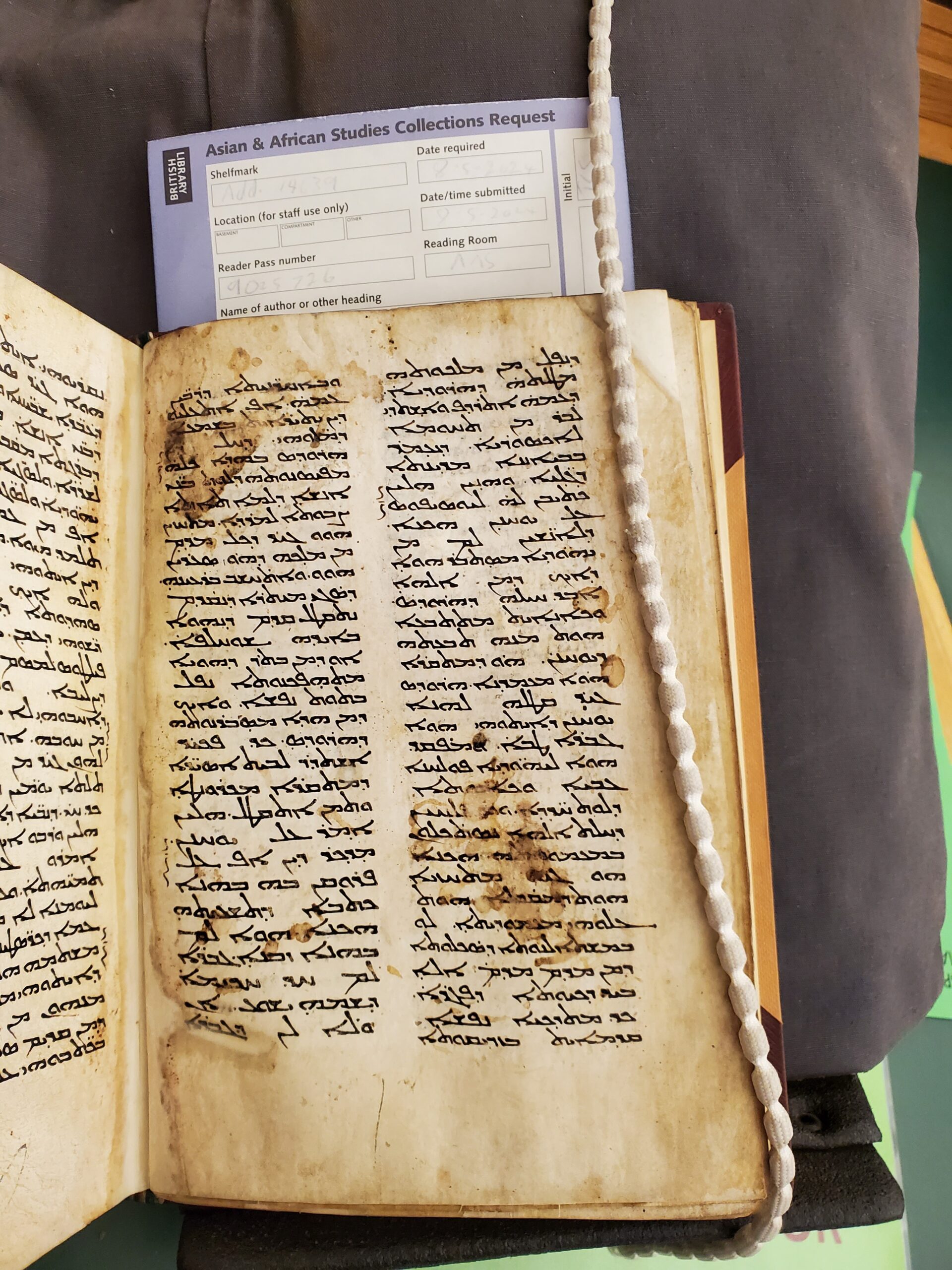 f.14a 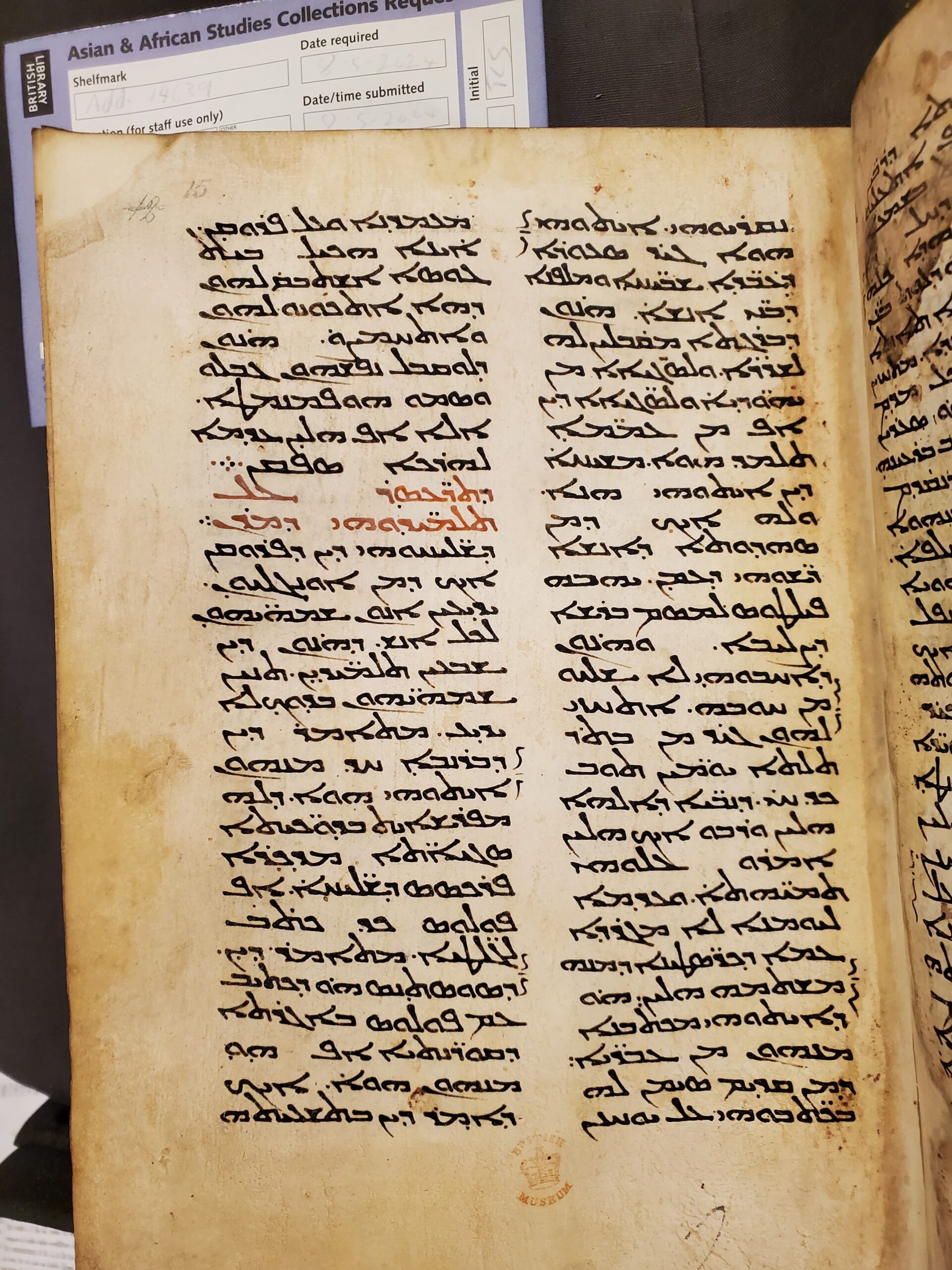 f.15b Pictures by TC Schmidt August 5, 2024 | |
| British Library Add.12154 folio 151r line 18–151v line 6 | 8th/9th century | Quotation of the Testimonium Flavianum excerpted from Syriac translation of Eusebius, Ecclesiastical History 1.11.7–8 | See image 11 in book | |
| Contains the important variant “It was thought that he was the Christ” (ܡܣܬܒܪܐ ܕܡܫܝܚܐ ܐܝܬܘܗܝ ܗܘܐ) | Archdiocese of Aleppo MS 250 S, folio 50r left column lines 15-27 (folio 47r in print edition), | 1598 CE | Michael the Syrian, Record of Times 5.10, composed in 1199 CE. However, Michael probably derived the Testimonium Flavianum from Jacob of Edessa’s Chronicle, composed before Jacob’s death in 708 CE | 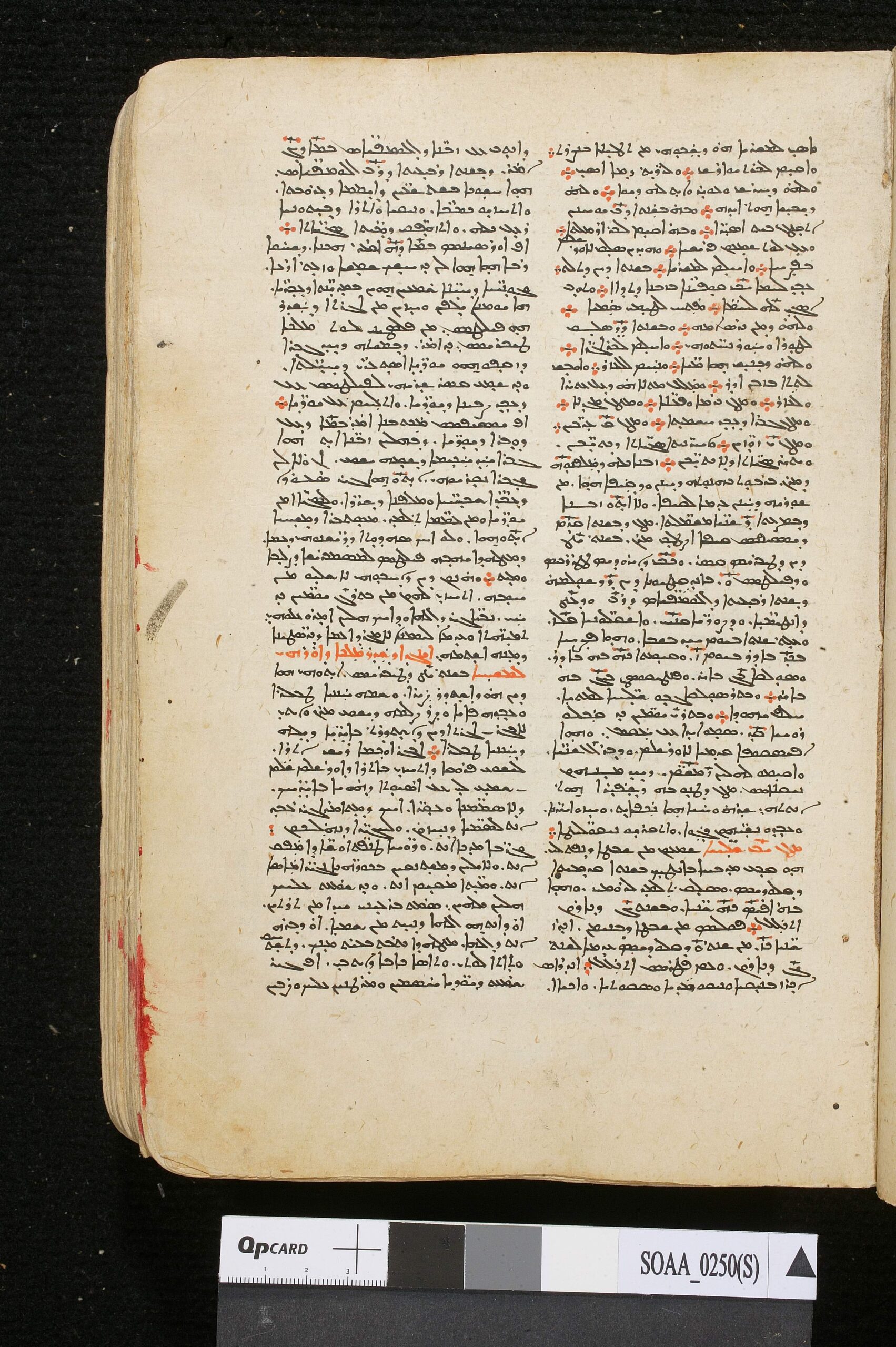 link to digitized manuscript |
| One of three known Armenian manuscripts of Eusebius, Ecclesiastical History. The other two date from the 1600s. The Armenian translation was based on the Syriac and was conducted at an unknown date, perhaps in the fifth century. It contains the important variant “a certain man” (այր մի). | Mechitaristarum Vindobonensis 49 (70 C), folio 15r line 21– 15v line 4 | 1695 CE | Eusebius, Ecclesiastical History 1.11.7–8 (Armenian translation, perhaps carried out in the fifth century) | See image 13 in book or link to catalog |
| This paraphrase of the Testimonium Flavianum is interesting because it presents a neutral interpretation, saying of Jesus, that “perhaps he was the Christ” (فلعله هو المسيح), among other similar things. This is the only manuscript containing this portion of Agapius’s work. | Biblioteca Medicea Laurenziana Or. 323, folio 6v line 11–7r line 2 | 1288 CE | Agapius, Book of History, composed around 941/2 CE. However, Agapius probably derived the Testimonium Flavianum from Jacob of Edessa’s Chronicle, composed before Jacob’s death in 708 CE. For more bibliographic information, see p. 49 in the book. | See image 14 in book |
| There is only one manuscript of the portion of Agapius’ work that includes the extract from Josephus, but this manuscript has scribal corruptions. Agapius is however quoted by a later Arabic writer named al-Makin whose version does not suffer from these corruptions. By using al-Makin scholars are hence able to reconstruct what Agapius originally wrote. | Bibliothèque nationale de France ar. 294 folio 163r lines 5-11 (folio 162v line 15 makes it clear that Al-makin is quoting from Agapius whom he calls “al-Manbijī”) | 14th-century | al-Makīn Ǧirǧis ibn al-ʿAmīd, 1280 AD | 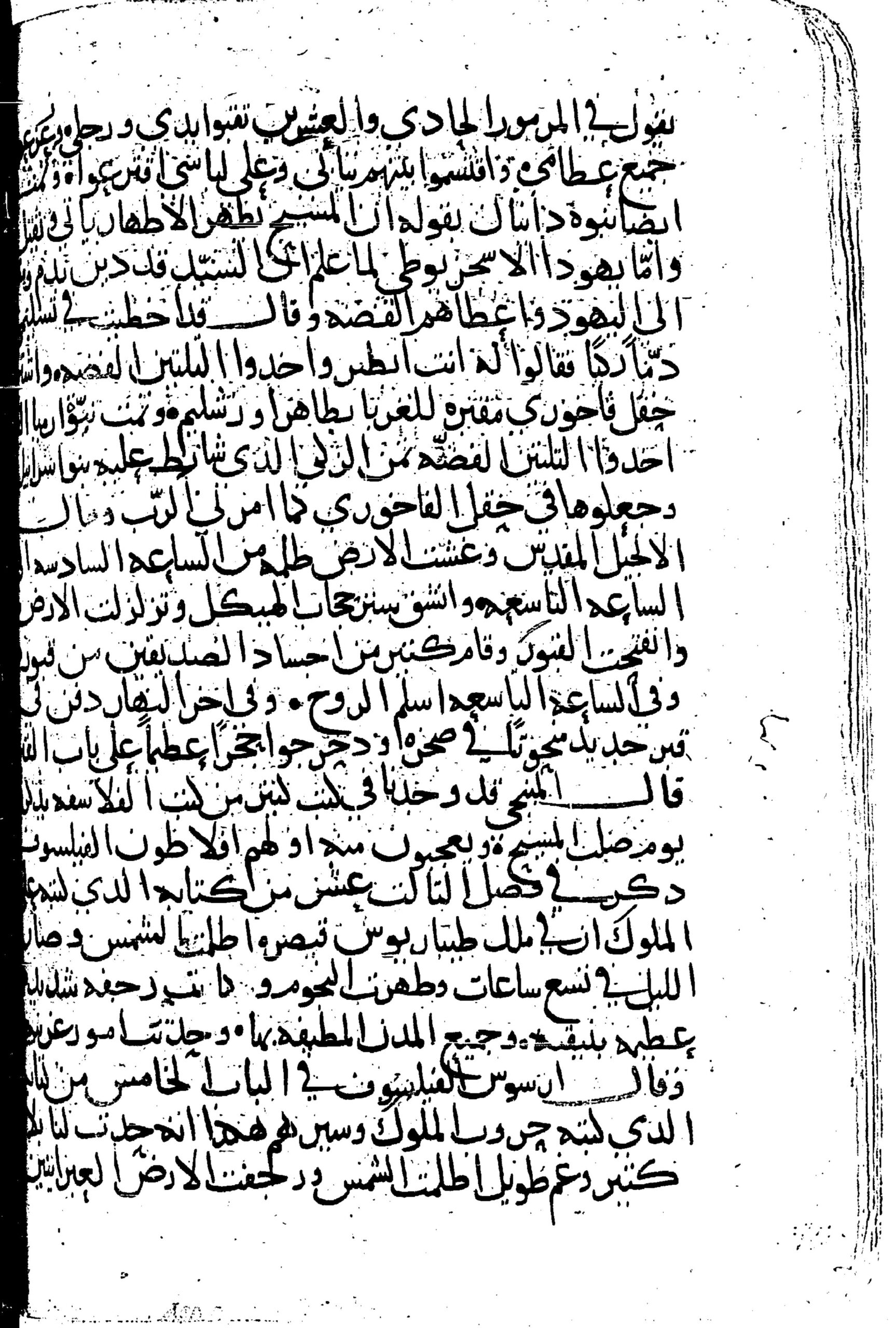 folio 162v 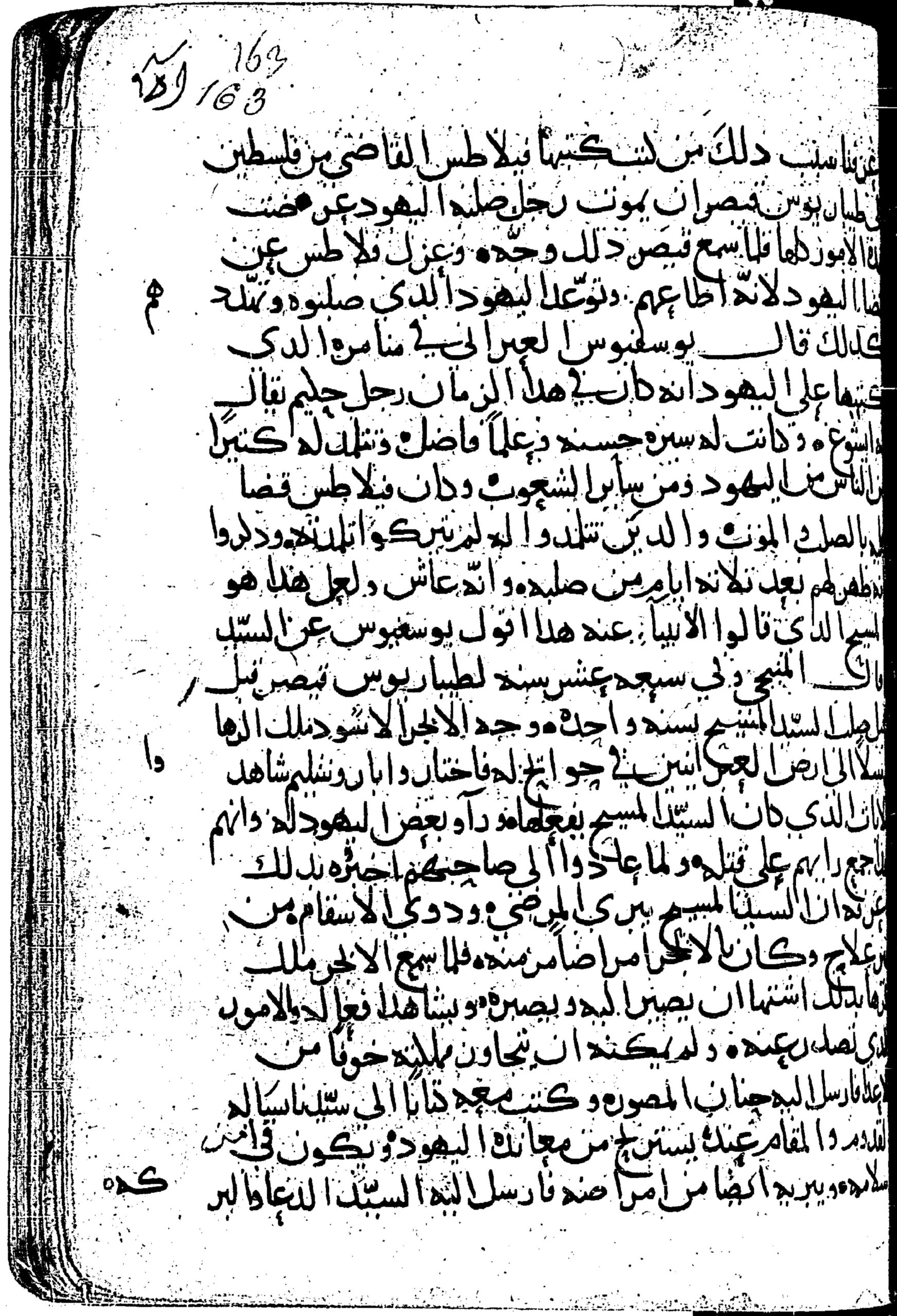 folio 163r Link to catalog. |